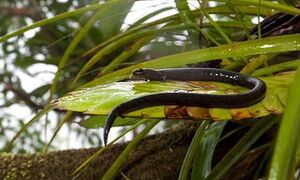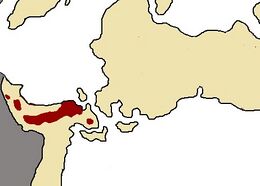Oedipina nigrescens
| Ochacan Long-tailed Salamander | |
|---|---|

| |
| Oedipina nigrescens | |
| Scientific classification | |
| Kingdom: | Animalia
|
| Phylum: | Chordata
|
| Class: | Amphibia
|
| Order: | Caudata
|
| Family: | Plethodontidae
|
| Genus: | Oedipina
|
| Species: | O. nigrescens
|
| Binomial name | |
| Oedipina nigrescens Martel et al., 1982
| |

| |
| Range of O. nigrescens in Inyursta | |
Oedipina nigrescens, the Ochacan Long-tailed salamander, is a species of salamander in the genus Oedipina. It is also known as the "Black Long-tailed salamander" or "Yana-qwarya" by the local indigenous Rim'talan Peoples, in reference to its colors.
It is remarkable due to its behavioral ecology, wherein it is both hyper-fossorial and hyper-arboreal, spending much of the year buried deep beneath the soil and the remainder of the year high up in the crevices and epiphyte microhabitats of trees.
Discovery
The Ochacan Long-tailed salamander was known to the Rim'talan people for centuries. During the Inyurstan Civil War, counter-revolutionary forces fighting in the area told of a long, rubbery snake-like creature with four legs and a prehensile tail.
In 1976, Dr. Ferdinand Martel led a small expedition into the reported locality, gleaned from then-commissioned Inyurstan soldiers. While his expedition was able to uncover a number of Inyurstan fauna previously unknown to science (such as the Sabo's Burrowing treefrog, they were unable to uncover the black climbing enigma. Due to violence in the region, all scientific expeditions were halting. Dr. Martel and his team got a second chance in 1982, with a small escort from the Inyurstan Army and new grant money from the (UNIVERSITY HERE). During this time, they were able to catch the seasonal transition between the dry season and rainy season. On the first monsoon, they observed multiple individuals emerging from the soaked soil and begin to climb trees. The emergence & migration event lasted about a week, but Martel had his first specimen of O. nigrescens.
Habitat & Conservation
Arboreal Cloud Forests
As a species with an extremely specialized behavioral ecology, the Ochacan Long-tailed salamander requires a very specific habitat. The ideal habitat is the ecotone between true lowland rainforest or swampland with upland or montane cloud forest. Such ecotones have deep, moist organic soils associated with lowland habitats, but tall trees which stretch into areas of higher elevation (along with a moisture & temperature gradient). For example, an area where the roots of a given tree might be in a consistently warm, humid jungle but the tall canopy & emergent layer stretches into cooler montane forest with a more persistent cloud layer.
Eggs are laid in the soil, and it is believed that juveniles spend their time under soil only to emerge as adults. However, a wild juvenile has never been found to date.
Drug Trade
The drug trade has been implicated in potential declines of this species. Production of coca releases chemical fertilizer into the soil, as well as altering the organic-clay balance of nearby terrestrial systems. This in turn affects the ability of O. nigrescens to reproduce, and further leakage of chemicals used in the process of refining coca leaves into cocaine also pollute the soil and cause downstream mortality of buried individuals. Coca production sites have been implicated in the extirpation of this species from at least two localities.
Increased foot and vehicle traffic - both from growers & traffickers as well as Inyurstan law enforcement forces battling them - may also cause mortality during the two narrow windows of surface migration at the start and end of the rainy season.
National Icon
In 1987, one of Dr. Martel's former graduate students, Stephano Monacassa, recorded a locality record for this species along the east-facing slope of Mesa de Sant-Élena. By 1990, access to the area was completely inaccessible due to heavy activity by the Ochaca Cartel. While drug labs were destroyed and coca plantations in the area burned by 1995, Monacassa (by then a PhD graduate) would not be granted access to the area until 1997. He discovered that in the 10 years since his last visit, the Ochacan Long-tailed salamander had been extirpated. In 1999, shortly before his retirement, Chief National Dominic Mendoza of the Inyurstan National Police met with Moncassa at the site of a recently cleared Juarez Cartel facility. Moncassa was able to find a live individual about 6cm under loose soil approximately 1km upstream of the drug lab, confirming their lingering presence at the site. Dominic Mendoza was then photographed holding the small salamander in both hands while standing next to the young biologist. Overnight the picture went sensational, and the plight of the Ochacan Long-tail was brought to national attention.
The Inyurstan government declared O. nigrescens to be a Specía acin Protèctçion level-2 (SaP-2) within a month. Units of the national police began wearing patches and undershirts depicting the ubiquitous amphibian, while hardline nationalists and softer environmentalists alike were able to unify under the icon of the Ochacan Long-tail as a rally cry against the cartel activity.
See Also
Related Species
Jungle Long-tailed salamander (Oedipina vulgarius)
Inyurstan Long-tailed salamander (Oedipina inyurstiensis)
Valle de Cheras Worm salamander (Oedipina antioqianus)
Inyurstan Species Lists
Inyurstan Herpetofaunal Checklist
Species Endemic to Inyursta
Relevant Scientists
Dr. Ferdinand Martel - Described the species, responsible for early discoveries on its biology
Dr. Stephano Monacassa - Continued Martel's work in the ecology & extant range of the species.